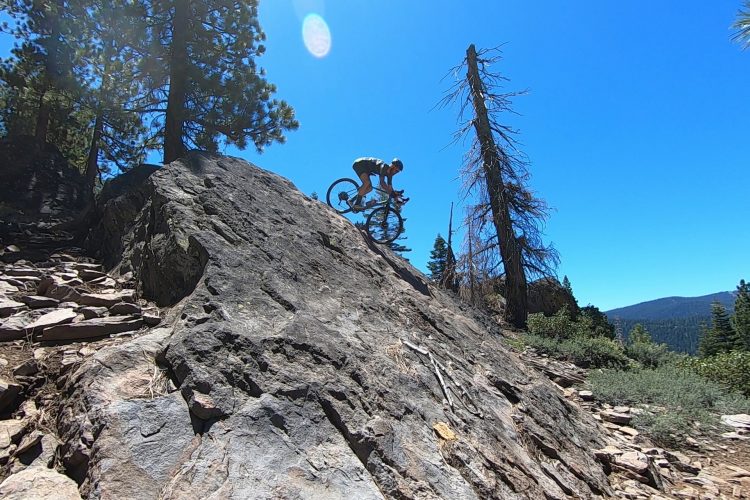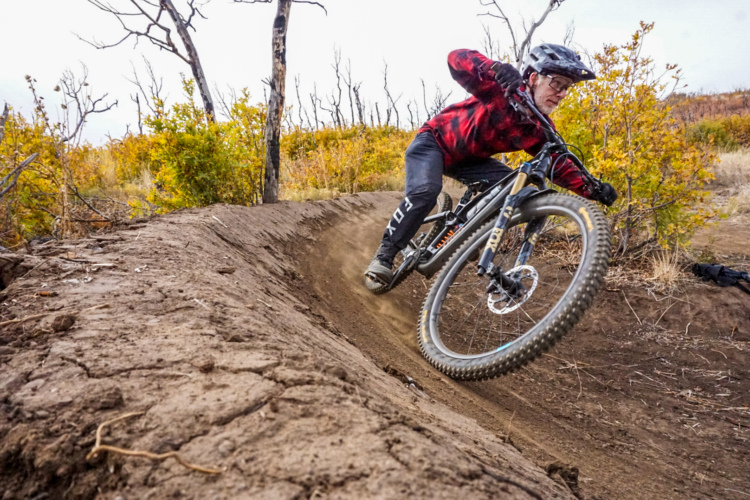My buddy Craig Durkin is a talented cyclist, an entrepreneur, and a bit of a mad scientist. A video of his latest contraption–a rail bike, for lack of a better name–caught my eye. To find out more about his rail bike and how it came to be, I sent some questions over to Craig.

Singletracks: Who are you, and what do you do?
Craig Durkin: I’m Craig Durkin and I co-founded Concrete Jungle here in Atlanta. We pick urban fruit trees, do some farming, and donate everything to in-town food banks and homeless shelters. I like making bike-powered things, and Concrete Jungle provides a good outlet for that: we’ve got a pedal-powered apple grinder we use for making cider, a bike blender for making smoothies/margaritas at our farm, a bike-powered water pump for gardening, and now this weird thing (which is obviously not related to picking fruit or farming).
What is your contraption? Does it have a name?
It’s an adapter to let me ride my bike on railroad tracks. Remove your front wheel, clamp your fork to the mount, and take off. To be clear: it’s meant for abandoned rail, but there’s plenty of that around. It needs a name though! People call them rail bikes or (velo)draisines, but I should probably put a little branding magic on this thing.

What was the inspiration for building it?
Man, railroads are just mysterious! There’s thousands of miles of them criss-crossing the US, and we only ever see a glimpse of them. And the bicycle is such a perfect tool for exploring the world. Plus, here in Atlanta there’s lots of cool rail history everywhere. The city is in the process of converting an old rail loop–the Beltline–to an urban trail and light rail system. I thought it’d be super cool to experience the Beltline by rolling along that old rail as trains once did.
Also there’s fun possibilities out there with these: on good rail it seems like you could go super fast because trains can’t climb hills and rail is really low friction. And if I build a second one of these, we could do couples goldsprints, or you could link them together and form a bike train.
How did you come up with the design? Was it a solo project or did you have help?
It’s been basically a solo project I would poke at in my spare time. Riding a bike on railroad track is something that people have been doing forever, but I’ve found existing designs to be lacking: people have made things that were super custom, would only work with one specific bike setup, or were dangerous. I wanted something that was simple to build and simple to use. There is a guy named Sergey Abramkin who has a nice design that I used as a starting point for my own. He’s got a fun video of him and some dude riding rails in the Ukrainian countryside in their undies.
What has the design process been like? How many iterations have you been through?
My first design goal was to make something that would support two bikes side-by-side, both because you need an adventure buddy and also because even single-bike rail bikes need an outrigger on the opposite rail, so that outrigger may as well be a second bike.
The next goal was to design it so that it would work with almost any bike. It should require no/little reconfiguring to work with your bike, your girlfriend’s bike, your nephew’s bike, etc. Put it on and go.
The last goal was to design something that could be easily built. A drill press, some metal tubing, and a trip to Home Depot should get you far. Currently I’m on the third version. I’ve been building it as simple as possible, and getting more complicated as needed. It’s pretty much done.
Any setbacks?
Plenty! Version 2 was lightweight but didn’t have any diagonal bracing, so it was super flexy. The bike would stay on the rail, but would lean so much that it seemed like it was trying to throw you off.
A few days ago two of our guide wheels got snagged in some weeds, stopped rotating, and started dragging along the rail. The friction melted part of the wheel, leaving us with lumpy, flat-spotted guide wheels. We had to do two emergency wheel swaps on the south Atlanta Beltline among loads of mosquitos, and I gained an appreciation for simplifying the design a bit (and maybe getting better wheels).
An abandoned rail can be pretty crappy. We spent a long time getting through a tunnel on the southside Beltline because it was flooded and had a downed tree and tons of mud.

How was it constructed? Any welding, or is it all bolted together?
As bolted together and off-the-shelf as possible. I had to get two pieces custom made–the metal triangles that support the fork mount–but they were cheap, simple, and I might be able to get rid of them.

Do you have to balance the rear wheel at all? Can it fall off the track?
There’s nothing holding the rear in place so it can technically fall off, but it’s never happened. It will drop occasionally if we’re hung up in super thick kudzu, but things are so messy at that point that it’s not unexpected. The rest of the time it’s fine: the front wheel of a bike is the only one that can steer so as long as it’s fixed to the rail, then the rear just follows along.
Any planned improvements?
As I touch on below, definitely getting it to pass through junctions will be a big improvement because we have to carry the whole setup over them right now. Road crossings are fun, though, because we get lots of good stares.
I’d like to reduce the part count some and make it more geared towards being easier to assemble. Figuring out a better central storage area would be nicer too, so you have a place for your front wheels and gear, and maybe a seat.
How do you handle rail junctions?
Right now we have to carry the whole setup over junctions, and it’s a pain. I’m working on that. My guide wheels are too big to fit through most junctions, so I’m getting some smaller ones and hoping that fixes it.

What’s your long term plan for this? Are you going to ride off into the sunset on abandoned rails?
Definitely! I’m going to ride as much abandoned rail in Atlanta as I can find, and am going to take it up to Maine this July. I’d love to get this to the point where me and a partner could each carry half of this thing and go on a multi-day trip that’s like half rail, half fire-road, or something. That would be amazing.










1 Comments
Jun 8, 2017